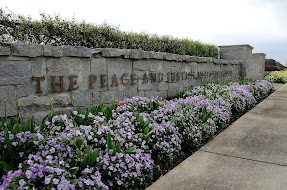The Peace and Justice Memorial
A few of my thoughts on our visit to the National Memorial for Peace and Justice. Part Architectural Review, par t Travel Log, part Personal Narrative.
We had timed tickets. The Lynching Memorial. We got there a few minutes early. A memorial garden sits outside the entrance. It looked like Spring, but the skies were roiling up with clouds ahead of the coming storms. The garden had as a focal point, a simple wall made of bricks formed by the hands of slaves.
I took some pictures around the outside of the building while we waited for it to open. It is quite a fantastic piece of architecture. Board formed concrete walls support 2x12 wooden slats forming a screened barrier that shifts the light as you pass by, giving dynamic life to the solid anchoring forms of the concrete.
Where we entered, a passage posted on the wall, plainly laid out a brief history, or narrative, of slavery and lynching. It described the “What” and “Why” of lynching, sanctioned murder. Beyond this wall, the view opens to a perfectly green and square interior courtyard. The path inclines gently clinging tightly to the perimeter wall. Ahead, out in the open and stark against the green field, is a vivid and agonizing statue of five or six Africans in chains, screaming in pain, a woman squatting in apparent birth, one man standing strong, others cowering against perceived beatings.
Lily asked why they were in chains.
Directly across from the sculpture more words are mounted on the wood slats that still clothe the concrete. These words condensed the “When” and “How” of lynching and a little more “Why”. Directly below the words, the concrete sidewalk began to diverge from the side wall. A few blades of glass poked out, like weeds through a cracked sidewalk; a small sign of life in an otherwise desolate landscape. The blades become a grassy patch that expands in a wedge towards a bench at the next corner, a resting place before the final approach to the covered memorial area. The grass appeared, from this perspective, hopeful and expanding from this history. Once at the corner and looking back the other way, the dwindling grassy strip was also clearly life being snuffed out in order to arrive at a place where human beings are dispensable property.
I didn’t rest at the bench. The storm was coming.

The first procession of monuments stood tall, apparently anchored to the ground, like so many bodies tied to trees. Around the first corner in the covered area, the ramp descends, the ground falls out from under you, and the monuments stay in the same plane. They detach from the ground and you enter a forest of suspended monuments to the counted hanging bodies, and the unknown. You are forced to walk among them. It is an arresting position to be in. For a moment while descending, you can no longer read the names of individuals printed on the side of the monuments, but you still know they are there. You are in a forest of Strange Fruit. Once below the level of the monuments (for an average person, about six feet under), you can see the names and dates and County names also cut from the bottom plate.
Words begin to adorn the walls. Metal plaques descend from the lines of monuments to highlight individual cases and causes. One died for looking. One died for walking. One died for voting. All died just for being, for existing as people with darker skin. I was filled with pity and anger and hatred and remorse and just as the wave of emotions became almost too great to bear, the path continues around the corner and under the suspended monuments, now completely out of reach. And confronting you is a long concrete wall washed in a continuous fall of water. The wall supports the hopeful words of another prominent defender of African humanity. The water is an endless flow of un-shed and well-deserved tears for those taken by such brutality and blind hatred. Or it is the cleansing waters of forgiveness, giving, light, and hope for a better future to everyone who just journeyed through this space. The falling water was also the first sound to break through the silence and solemnity of the place. I might argue that there’s nothing more worldly unifying as the sound of water, whether it be the rhythmic murmur of crashing waves, the steady gurgle of a flowing stream, or the constant patter of falling rain. The search for life is marked by the search for water. It is something we all know and must have.
It was a powerful and moving place to be. And it was not lost on me that we were a white family of four walking through this place. All the visitors were white. All the staff, the stewards of this history, were black. We were literal tourists, stepping into this story for a moment, looking around, feeling it, and then stepping out again.
What a privilege.















Comments